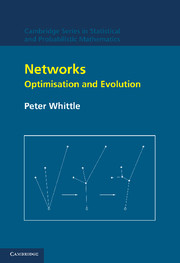Book contents
- Frontmatter
- Contents
- Acknowledgements
- Conventions on notation
- Tour d'Horizon
- Part I Distributional networks
- Part II Artificial neural networks
- Part III Processing networks
- Part IV Communication networks
- Appendix 1 Spatial integrals for the telephone problem
- Appendix 2 Bandit and tax processes
- Appendix 3 Random graphs and polymer models
- References
- Index
Part I - Distributional networks
Published online by Cambridge University Press: 23 November 2009
- Frontmatter
- Contents
- Acknowledgements
- Conventions on notation
- Tour d'Horizon
- Part I Distributional networks
- Part II Artificial neural networks
- Part III Processing networks
- Part IV Communication networks
- Appendix 1 Spatial integrals for the telephone problem
- Appendix 2 Bandit and tax processes
- Appendix 3 Random graphs and polymer models
- References
- Index
Summary
By ‘distributional networks’ we mean networks that carry the flow of some commodity or entity, using a routing rule that is intended to be effective and even optimal. The chapter titles give examples. Operational research abounds in such problems (see Ball et al., 1995a,b and Bertsekas, 1998), but the versions we consider are both easier and harder than these. In operational research problems one is usually optimising flow or operations upon a given network, whereas we aim also to optimise the network itself. Even the Bertsekas text, although entitled Network Optimization, is concerned with operation rather than design. The design problem is more difficult, if for no other reason than that it cannot be settled until the operational rules are clarified. On the other hand, there may be a simplification, in that the optimal network is not arbitrary, but has special properties in its class.
The ‘flow’ may not be a material one – see the Michell structures of Chapters 7–9, for which the entity that is communicated through the network is stress. The communication networks of Part IV are also distributional networks, but ones that have their own particular dynamic and stochastic structure.
Information
- Type
- Chapter
- Information
- NetworksOptimisation and Evolution, pp. 7 - 8Publisher: Cambridge University PressPrint publication year: 2007
